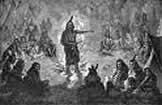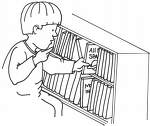Once upon a time, there was no such thing as children's lit - that is, a literature written specifically for children. Until fairly recently, children listened to (and, after the invention of the printing press, read) the same stories that adults did, usually around a fire after all the day's work had been completed. |
 |
| Stories were used to teach, to entertain and to pass on vital information about a culture, and children were included equally with adults, learning the stories well and passing them along to their own children as they matured. |
 |
The face of children's literature also changed with the advancing technology for printing books. At the advent of the printing press, books were only available to the nobility and other elite members of a society. Young children learned to read with "hornbooks" - little wooden paddles that had lessons or prayers printed on them. |
Naturally, most of those early printed works were textbooks, called "primers" designed to aid children in their studies, both academic and religious. These primers were instructional in nature, and not meant to be entertaining or even enjoyable for the children of the age, who got most of their pleasure in literature from oral stories, such as fairy tales and legends and stories from mythology and from religious sources |
.  |
It wasn't until attitudes about children, and childhood itself, began to change that children were offered literature that would delight as well as instruct them. The content of these new books was still instructional (or didactic) in nature, but the delivery of the instruction began to include illustrations, rhymes, and other stylistic elements that recognized the child as a special kind of learner, different from adults. Fairy and folk tales from antiquity were recorded and published, along with newer forms of nursery rhymes, adventure tales and fantasy stories. |
 |
The 20th century, with its gentler and more nurturing views of child-rearing, saw an explosion of literature written for and marketed to children, which we still see exploding today. Cheap printing made it possible for families to have whole libraries devoted just to their children, and with the new found competition in the field, authors and illustrators began to pay careful attention to the quality of their work. |
| Children's literature was established as a distinct genre, and awards, such as the Newbery Medal, were given to honor the best of the best. The field gave birth to several sub-genres: picture books, comic books, non-fiction, fantasy, poetry, magazines and serial fiction, realistic fiction and more. |
 |
 |
In the 21st century, we see no sign that the meteoric expansion of this field is slowing. Children's literature is a booming business, as evidenced by the astronomical number of books being published for and marketed to children.
There are significant changes, however, in the format of the presenation of literature to children. Increasingly, technology influences the way our children read, are read to, and interact with text of all kinds.
|
| The changes in the way these books are presented to children reflect our current cultural attitudes and research about who children are, what they are like, what they need and what they are interested in.We'll be discussing the implication of these changes in this module, identifying current trends in children's book publishing, and what those trends tell us about how we perceive children in the 21st century, both in this culture and elsewhere. |
|





